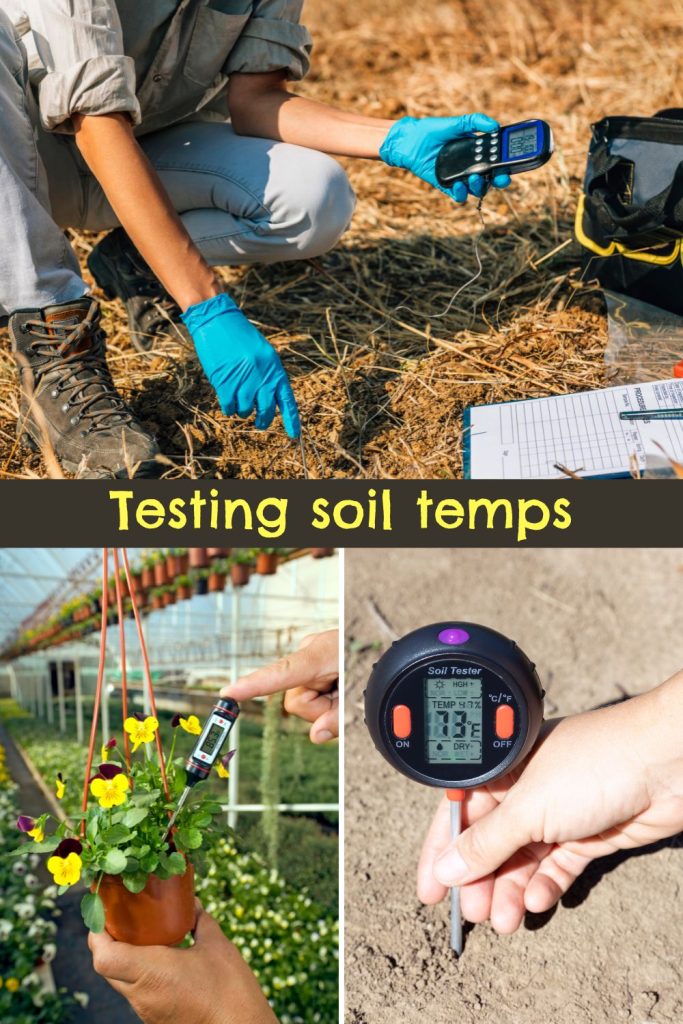Successful gardening goes beyond simply sowing seeds or planting seedlings, watering, and waiting for the magic to happen. It requires a balance of many factors that all contribute to healthy plant growth. One often overlooked metric is soil temperature.
Monitoring soil temperature provides insightful data that can make a difference in the health of your plants. This article will delve into the importance of soil temperature, how to measure it, and the optimum soil temperatures for various plants.
RELATED: See also, plant hardiness zones and heat map zones.
Understanding Soil Temperature
Soil temperature is a crucial determinant of the overall health and productivity of your garden. This often underrated gardening metric influences several aspects of plant growth.
How Soil Temperature Affects Your Soil and Plant Ecosystem
The American Horticultural Society’s (AHS) Heat Zone Map and the USDA’s Hardiness Zone Map are tools you can use to understand the climatic conditions of your area and choose plants that are likely to thrive.
However, in addition to these maps, understanding how temperature affects your soil and its inhabitants is crucial.
Germination
Different plant species have varied optimal temperature ranges for seed germination. Some seeds will not germinate at all if the soil temperature is too low or too high, while others may just take a little longer.
Similarly, if you’re germinating your seeds indoors, you’ll want to make sure that when you transplant them to the garden, the soil temperature will be consistently warm enough to keep them growing on.
Root Development
Root development, which is a critical phase in a plant’s life cycle, is also heavily influenced by soil temperature. Challenging soil temps can lead to weak or slow root development, which in turn affects the plant’s ability to absorb nutrients and water.
Most plants prefer soil temperatures between 65-75°F (18-24°C) for optimal root growth.
Nutrient Availability and Soil Organisms
Soil temperature affects microbial activity, and by extension, nutrient availability. Microbes break down organic matter into nutrients that plants can use. However, these microbes become less active as soil temperatures drop, slowing the nutrient cycling process.
Most soil microorganisms such as bacteria and fungi thrive at moderate temperatures, typically between 68-95°F (20-35°C).
Earthworms and many soil-dwelling insects, AKA macroorganisms, can experience stress above 77°F (25°C).
Measuring Soil Temperature
Tools for Measuring Soil Temperature
Digital Soil Thermometers
To measure soil temperature accurately, you need a soil thermometer. We’ve used a laser thermometer for a few years now for testing soil air temps, however, for the most accurate reading of the actual soil temperature, it’s best to use a soil thermometer with a probe that can read 3-6 inches down.
Digital soil thermometers can be inserted directly into the soil to give an instant and accurate reading of the current temperature of the soil that will surround your plant’s roots.
FREE Real Time Digital Soil Temperature Apps Online
- USA – GreenCastOnline: Real time soil temps and more for anywhere in the USA.
- GLOBAL – SoilTemperatureApp.com – This is a really cool soil temperature app that allows you to search real time soil temps and moisture estimates for anywhere in the world!
- NC STATE Extension Services: Some state extension services may have their own app, like that sample pictured below for our North Carolina State Ext. that includes a real time soil test tool for NC.

When and How to Measure Soil Temps
- Best Time: Mornings
- Depth:
- 3 inches for annuals
- 6 inches for perennials and deep-rooted plants
Optimum Soil Temperatures for Different Types of Plants
Every plant species has a particular temperature range within which it thrives best. For instance:
Warm-Season Vegetables
Warm-season vegetables like tomatoes, peppers, and cucumbers prefer a soil temperature range of 70°F to 85°F.
Cool-Season Vegetables
On the other hand, cool-season vegetables like radishes, spinach, and lettuce can thrive in lower soil temperatures, typically between 50°F and 65°F.
Perennial Plants
Perennials such as roses, lilies, and hydrangeas prefer a soil temperature range of 55°F to 75°F.
In Summary
Utilizing this simple tool can help your plants get off on the right foot (or roots!), and grow strong and healthy, which will also help protect them from attack by pests like aphids.
But… if any plants do get them, here’s how to get rid of aphids naturally.
And if you need more climate information, you may also enjoy reading plant hardiness zones and heat map zones.

I’m LeAura Alderson, a garden, herb and plant enthusiast with a passion for discovering the many edible and medicinal benefits of the plants all around us, including the weeds! I’m a writer, editor and media publisher for our family of websites.
While I was certified in fitness and life coaching, I am NOT a health practitioner. However, I’m a lifelong health enthusiast, with a keen interest in healthy, organic foods and making home remedies and the content we share is from our own experience and usage as well as that extracted from scientific research so that you can explore further on your own.
Always seek the advice and guidance of your health practitioners first and foremost.
As a family we’re steadily expanding our gardening, experimentation and knowledge around all things gardening, edible landscaping, fresh organic foods and self sustainability with farming in our future. I also own and manage iCreateDaily.com, a site all about transformation through creation, and the power of positivity, optimism and mindset.

